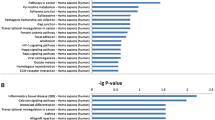Abstract
Purpose: Although cDNA array technique has recently become available in the cardiovascular field, it has not yet been established what kind of genes in the myocardium are expressed by acute ischemia. Since many substances contribute to the pathophysiology of acute ischemic hearts, we investigated transcription responses of murine hearts to ischemia using cDNA array representing 18,376 genes.
Methods and Results: In 29 male mice, we ligated the proximal site of the left coronary artery for 60 min. In 14 mice, we performed the sham operation without the ligation of the left coronary artery. After 60 min, the hearts were excised to obtain mRNA, and we performed cDNA array analysis. In 18,376 cDNA, 2 known genes were upregulated over 10-fold, 11 known genes were upregulated 5.0-to 9.9-fold, and 32 unknown genes were upregulated over 5.0-fold compared to sham-operated controls. In contrast, 11 known genes and 7 unknown genes were downregulated to levels below 0.2-fold. For 9 of the 13 known genes of which expression was increased as analyzed by cDNA array, subsequent Northern blot analysis also revealed an increase in expression.
Conclusion: Using cDNA array analysis we found that cardiac expression of 24 known and 39 unknown genes was modulated by acute ischemic stress, and appeared to be related to the pathophysiology of ischemic hearts. These results show that cDNA array analysis may provide a new molecular insight to the pathophysiology of acute ischemic hearts.
Similar content being viewed by others
References
Allen DG, Orchard CH. Myocardial contractile function during ischemia and hypoxia. Circ Res 1987; 60: 153-68.
Iyer VR, Eisen MB, Ross DT, et al. The transcriptional program in the response of human fibroblast to serum. Science 1999; 283: 83-87.
Ferea TL, Brown PO. Observing the living genome. Curr Opin Genet Dev 1999; 9:7 15-22.
Duggan DJ, Bittner M., Chen Y, Meltzer P, Trent JM. Expression profiling using cDNA microarrays. Nat Genet 1999; 21: 10-14.
DeRisi J, Penland L, Brown PO, et al. Use of a cDNA microarray to analyse gene expression patterns in human cancer. Nat Genet 1996; 14: 457-60.
Khan J, Simon R, Bittner M, et al. Gene expression profiling of alveolar rhabdomyosarcoma with cDNA microarrays. Cancer Res 1998; 58:50 09-13.
Perou CM, Jeffrey SS, van de Rijn M, et al. Distinctive gene expression patterns in human mammary epithelial cells and breast cancers. Proc Natl Acad Sci USA 1999; 96:92 12-17.
Feng Y, Yang JH, Huang H, et al. Transcriptional profile of mechanically induced genes in human vascular smooth muscle cells. Circ Res 1999; 85:11 18-23.
Haley KJ, Lilly CM, Yang JH, et al. Overexpression of eotaxin and the CCR3 receptor in human atherosclerosis: Using genomic technology of identify a potential novel pathway of vascular inflammation. Circulation 2000; 102:21 85-89.
Johnatty SE, Dyck JR, Michael LH, Olson EN, Abdellatif M. Identification of genes regulated during mechanical loadinduced cardiac hypertrophy. J Mol Cell Cardiol 2000; 32:8 05-15.
Stanton LW, Garrard LJ, Damm D, et al. Altered patterns of gene expression in response to myocardial infarction. Circ Res 2000; 86:9 39-45.
Lyn D, Liu X, Bennett NA, Emmett NL. Gene expression profile in mouse myocardium after ischemia. Physiol Genomics 2000; 2: 93-100.
Node K, Kitakaze M, Kosaka H, et al. Bradykinin mediation of Ca2+-activatedK+ channels regulates coronary blood flow in ischemic myocardium. Circulation 1997; 95:15 60-67.
Liu Q, Clanachan AS, Lopaschuk GD. Acute effects of triiodothyronine on glucose and fatty acid metabolism during reperfusion of ischemic rat hearts. Am J Physiol 1998; 275:E3 92-99.
Hsu RB, Huang TS, Chen YS, Chu SH. Effect of triiodothyronine administration in experimental myocardial injury. J Endocrinol Invest 1995; 18:7 02-09.
Tomanek RJ, Zimmerman MB, Suvarna PR, Morkin E, Pennock GD, Goldman S. A thyroid hormone analog stimulates angiogenesis in the post-infarcted rat heart. J Mol Cell Cardiol 1998; 30:9 23-32.
Agocha A, Lee HW, Eghbali-Webb M. Hypoxia regulates basal and induced DNA synthesis and collagen type I production in human cardiac fibroblasts: Effects of transforming growth factor-beta1, thyroid hormone, angiotensin II and basic fibroblast growth factor. J Mol Cell Cardiol 1997; 29:22 33-44.
Guardavaccaro D, Ciotti MT, Schafer BW, Montagnoli A, Tirone FJ. Inhibition of differentiation in myoblasts deprived of the interferon-related protein PC4. Cell Growth Differ 1995; 6:1 59-69.
Buanne P, Incerti B, Guardavaccaro D, Avvantaggiato V, Simeone A, Tirone F. Cloning of the human interferonrelated developmental regulator (IFRD1) gene coding for the PC4 protein, a member of a novel family of developmentally regulated genes. Genomics 1998; 51:2 33-42.
Sun L, Liu Y, Fremont M, et al. A novel 52 kDa protein induces apoptosis and concurrently activates c-Jun Nterminal kinase 1 (JNK1) in mouse C3H10T1/2 fibroblasts. Gene 1998; 208:1 57-66.
Ohno M, Takemura G, Ohno A, et al. “Apoptotic” myocytes in infarct area in rabbit hearts may be oncotic myocytes with DNA fragmentation: Analysis by immunogold electron microscopy combined with in situ nick end-labeling. Circulation 1998; 98:14 22-30.
Gottlieb RA, Engler RL. Apoptosis in myocardial ischemiareperfusion. Ann N Y Acad Sci 1999; 874:4 12-26.
Steenbergen C, Hill ML, Jennings RB. Cytoskeletal damage during myocardial ischemia: Changes in vinculin immunofluorescence staining during total in vitro ischemia in canine heart. Circ Res 1987; 60:4 78-86.
DeRisi J, Penland L, Brown PO, et al. Use of a cDNA microarray to analyse gene expression patterns in human cancer. Nat Genet 1996; 14:4 57-60.
Heller RA, Schena M, Chai A, et al. Discovery and analysis of inflammatory disease-related genes using cDNA microarrays. Proc Natl Acad Sci USA 1997; 94:2 150-55.
Aitman TJ, Glazier AM, Wallace CA, et al. Identification of Cd36 (fat) as an insulin-resistance gene causing defective fatty acid and glucose metabolism in hypertensive rats. Nat Genet 1999; 21: 76-83.
Author information
Authors and Affiliations
Rights and permissions
About this article
Cite this article
Kitakaze, M., Asakura, M., Sakata, Y. et al. cDNA Array Hybridization Reveals Cardiac Gene Expression in Acute Ischemic Murine Hearts. Cardiovasc Drugs Ther 15, 125–130 (2001). https://doi.org/10.1023/A:1011118828197
Issue Date:
DOI: https://doi.org/10.1023/A:1011118828197




